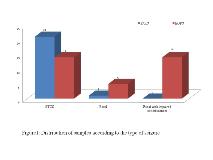Essential Oil-Induced (EOIS) and Provoked Seizures (EOPS): A Multicentric Prospective Observational Study From South India
Abstract number :
1.435
Submission category :
17. Public Health
Year :
2018
Submission ID :
488472
Source :
www.aesnet.org
Presentation date :
12/1/2018 6:00:00 PM
Published date :
Nov 5, 2018, 18:00 PM
Authors :
Thomas Mathew, St. John's Medical College Hospital; Vikram Kamath, Apollo Hospital; Rakesh Jadav, Apollo Hospital; Sreekanta Swamy, Apollo Hospital; Shivakumar R, Sakra World Hospital; Gurucharan Adoor, Vydehi Institute of Medical Sciences; Raghunandan Na
Rationale: Essential oils like eucalyptus and camphor are known to be epileptogenic. These essential oils are present in many over the counter balms and oils which are often used by people for common ailments like headache and common cold. In this study we evaluated the relationship between exposure to these essential oils and first episode of seizure/ breakthrough seizures in people with epilepsy. Methods: This was a multi-centre prospective observational study, conducted in four major hospitals, in south India from October 2014 to March 2018. Every patient of seizure/ epilepsy presenting with first episode of seizure or recurrent seizure was asked about exposure to essential oils (EO), mode of exposure, time to onset of seizure, duration of seizure, type of seizure, antiepileptic drug therapy and was followed up for recurrence physically and telephonically. Essential oil-induced seizure (EOIS) was defined 1) seizure after exposure to essential oil 2) temporally related 3) no previous history of seizure 4) no recurrence after stopping essential oil exposure 5) minimum follow up of 6 months. Essential oil provoked seizures (EOPS) was diagnosed when, 1) seizure occurred after exposure to essential oil 2) temporally related 3) known case of epilepsy/epileptic syndrome 4) compliant with anti epileptic medications 5) no other cause of seizure recurrence. Results: During the 3 years period there were 55 patients from four major hospitals who had essential oil related seizure. 22 had EOIS and 33 EOPS. Male: Female ratio was 1:1, age range 8 months -77 years. In EOIS group 95% had generalised tonic clonic seizures and 5% had focal seizures while in EOPS group 42% had generalised tonic clonic seizures, 15 % focal seizures and 43% had focal seizures with impaired awareness. EO implicated were preparations containing eucalyptus oil and camphor. Commonest commercial preparations used were Amrutanjan, Zandu balm and Vicks Vaporub. Modes of exposure were local in 76%, inhalation 18% and ingestion in 6%. Time to seizure was 30 min to 12 hours after local application, 2 min to 30 minutes after inhalation and 30 min to 3 hours after ingestion. None of our EOIS patients had recurrence of seizures after stopping the EO exposure. Majority of patients (94%) in the EOPS group also did not have any recurrence on follow up. Conclusions: EOIS and EOPS are commonly misdiagnosed as idiopathic seizures. Identifying the true causative factor will prevent unnecessary antiepileptic drug therapy and future recurrence. Essential oil exposure should be asked while taking history in any patient with first episode of seizure or recurrence of seizure. Future multi-centric multi-national studies involving larger number of patients is needed to ascertain the true severity of this problem as these oils are used world over. Funding: Nil

.tmb-.jpg?Culture=en&sfvrsn=a4eb9a51_0)